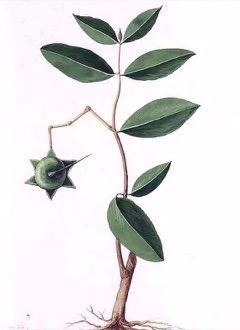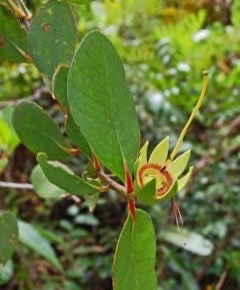 |
|
http://www.edibleplants.org |
 |
| Wibowo Djatmiko (Wie146), wikimedia.org |
Translate this page:
Summary
Sonneratia caseolaris or known as Firefly Mangrove, Red-flowered Pornupan Mangrove, or Mangrove Apple is an evergreen, tropical, medium-sized tree with columnar crown growing about 6-20 m tall and 30 cm in trunk diameter, commonly in East Asia. It has pencil-like pneumatophores, or aerial roots. The trunk is swollen at the base when young. The leaves are thick but narrow, opposite, and leathery. The flowers occur singly, with red, narrow petals, and green sepals. The fruits are round and hard containing many seeds. The fruits, known source of pectin, are cooked, or used for vinegar or beverages. Young fruits are used as flavoring. Young leaves can be consumed raw. The plant is a folk remedy for sprains, swellings, and worms. It is also used against coughs, hematuria, smallpox, and cuts and bruises. The plant is planted in coastal swamp areas to control soil erosion. The bark is a tannin source. Vertical roots are used as floats for fish nets and in the manufacture of inner soles for shoes. The wood is used for piles, posts, poles, railway t
Physical Characteristics

 Sonneratia caseolaris is an evergreen Tree growing to 15 m (49ft) by 15 m (49ft) at a medium rate.
Sonneratia caseolaris is an evergreen Tree growing to 15 m (49ft) by 15 m (49ft) at a medium rate.
See above for USDA hardiness. It is hardy to UK zone 10. The flowers are pollinated by Moths, bats, birds.
It is noted for attracting wildlife.
Suitable for: light (sandy), medium (loamy) and heavy (clay) soils and can grow in heavy clay soil. Suitable pH: mildly acid, neutral and basic (mildly alkaline) soils and can grow in very alkaline and saline soils.
It cannot grow in the shade. It prefers moist or wet soil.
UK Hardiness Map
US Hardiness Map
Synonyms
Blatti acida (L. f.) Lam. Rhizophora caseolaris L. Sonneratia acida L. f. Sonneratia evenia Blume So
Plant Habitats
Edible Uses
Edible Parts: Fruit Leaves
Edible Uses: Pectin
Young berries - raw or cooked[301 , 451 ]. They can be eaten as a fruit, or cooked as a vegetable[418 ]. A sour flavour[451 ]. A cheese-like flavour[301 ]. The fruits are a source of pectin[418 ]. Young leaves - raw[418 ].
References More on Edible Uses
Medicinal Uses
Plants For A Future can not take any responsibility for any adverse effects from the use of plants. Always seek advice from a professional before using a plant medicinally.
Antitussive Haemostatic Parasiticide Poultice Skin
The plant is said to be haemostatic[269 ]. It is a folk remedy for sprains, swellings, and worms[269 ]. The old fruit walls are used as a treatment for worms[269 ]. Half-ripe fruits are a treatment for coughs[269 ]. The fruits are used to make poultices[269 ]. The pounded leaves are used as a treatment for haematuria and smallpox[269 ]. The leaves are crushed, mixed with salt and applied as a poultice onto cuts and bruises[269 ].
References More on Medicinal Uses
The Bookshop: Edible Plant Books
Our Latest books on Perennial Plants For Food Forests and Permaculture Gardens in paperback or digital formats.

Edible Tropical Plants
Food Forest Plants for Hotter Conditions: 250+ Plants For Tropical Food Forests & Permaculture Gardens.
More

Edible Temperate Plants
Plants for Your Food Forest: 500 Plants for Temperate Food Forests & Permaculture Gardens.
More

More Books
PFAF have eight books available in paperback and digital formats. Browse the shop for more information.
Shop Now
Other Uses
Fuel Furniture Parasiticide Pectin Pioneer Soil stabilization Tannin Wood
Agroforestry Uses: A very important tree in the coastal swamp community, helping to protect the soil from erosion and providing an important habitat for wildlife[K ]. A fast-growing, pioneering species that colonizes newly formed mudflats and can expand rapidly in number, especially in optimum conditions of low salinity[338 ]. Other Uses The pneumatophores (vertical roots rising above ground) are used as floats for fish nets and, being corky in texture, are employed in the manufacture of inner soles for shoes and can be used as a substitute for cork or pith[345 ]. The roots are boiled before being used[451 ]. The bark is a source of tannins[418 ]. The heartwood is light brown to dark chocolate, the sapwood light greyish brown and 3 - 8cm thick[345 ]. When wet or under varnish, the heartwood of old mature trees looks almost black. The grain is straight or very slightly crossed; the texture fine, very homogeneous, smooth, but not glossy; it has a distinct salty taste and a fishy or swampy odour, especially when fresh[345 ]. The wood is moderately hard and moderately heavy to heavy[345 ]. It is easy to work; lasts well in the ground and even the sapwood is rarely attacked by insects; the heartwood is said to resist teredos very well[345 ]. The wood contains a small amount of salt, making the use of copper nails and screws necessary. It is used for piles, posts, poles, railway ties, paving blocks; ship, bridge, and wharf building; general strong construction; doors; siding, sheathing, ceiling, flooring, and all kinds of interior finish; ship planking and decking; furniture and cabinetwork; and musical instruments[345 ]. The wood is used for fuel, but only when better woods are not available[451 ].
Special Uses
Attracts Wildlife Food Forest
References More on Other Uses
Cultivation details
A plant of coastal areas in the tropics. It grows best where the mean annual minimum and maximum temperatures are within the range 20 - 30°c, though it tolerates 10 - 38°c[418 ]. It prefers a mean annual rainfall of 1,500 - 2,500mm, tolerating 1,000 - 3,000mm, and succeeds in areas with no dry season as well as those with a dry season. Prefers a sunny position[418 ]. Prefers a heavy soil, but tolerates most soil types[418 ]. Grows in areas that are inundated by salt water at high tides. Prefers a pH in the range 6.7 - 7.3, but tolerates 6.5 - 7.5[418 ]. Plants are tolerant of strong, salt-laden winds. The flowers are nocturnal, opening in the evening and closing in the early morning[451 ].
References Carbon Farming Information and Carbon Sequestration Information
Temperature Converter
Type a value in the Celsius field to convert the value to Fahrenheit:
Fahrenheit:
The PFAF Bookshop
Plants For A Future have a number of books available in paperback and digital form. Book titles include Edible Plants, Edible Perennials, Edible Trees,Edible Shrubs, Woodland Gardening, and Temperate Food Forest Plants. Our new book is Food Forest Plants For Hotter Conditions (Tropical and Sub-Tropical).
Shop Now
Plant Propagation
Seed - it has a low viability of less than three months[338 ].
Other Names
If available other names are mentioned here
Red-flowered Pornupan mangrove, Ampie-lpu, Archa, Archaka, Ban chua, Bedat, Bedata, Berembang, Berombong, Betah, Bidada, Blatti, Bogem, Chipi, Gedaba, Jedaba, Kandale, Kapidada, Kinnari, Kirala, Lam pu, Lampoo, Ora, Orcha, Pat, Pedada, Perepat, Sundarignua, Thirala, Tiwar, apple mangrove|kirilla / kirala.
Native Range
TEMPERATE ASIA: China TROPICAL ASIA: India, Sri Lanka, Cambodia, Thailand, Vietnam, Indonesia, Malaysia AUSTRALASIA: Australia (Queensland)
Weed Potential
Right plant wrong place. We are currently updating this section.
Please note that a plant may be invasive in one area but may not in your area so it's worth checking.
Conservation Status
IUCN Red List of Threatened Plants Status : Status: Least Concern

Growth: S = slow M = medium F = fast. Soil: L = light (sandy) M = medium H = heavy (clay). pH: A = acid N = neutral B = basic (alkaline). Shade: F = full shade S = semi-shade N = no shade. Moisture: D = dry M = Moist We = wet Wa = water.
Now available:
Food Forest Plants for Mediterranean Conditions
350+ Perennial Plants For Mediterranean and Drier Food Forests and Permaculture Gardens.
[Paperback and eBook]
This is the third in Plants For A Future's series of plant guides for food forests tailored to
specific climate zones. Following volumes on temperate and tropical ecosystems, this book focuses
on species suited to Mediterranean conditions—regions with hot, dry summers and cool, wet winters,
often facing the added challenge of climate change.
Read More
Expert comment
Author
(L.) Engl.
Botanical References
Links / References
For a list of references used on this page please go here
A special thanks to Ken Fern for some of the information used on this page.
Readers comment
| Add a comment |
|
If you have important information about this plant that may help other users please add a comment or link below. Only comments or links that are felt to be directly relevant to a plant will be included. If you think a comment/link or information contained on this page is inaccurate or misleading we would welcome your feedback at [email protected]. If you have questions about a plant please use the Forum on this website as we do not have the resources to answer questions ourselves.
* Please note: the comments by website users are not necessarily those held by PFAF and may give misleading or inaccurate information.
To leave a comment please Register or login here All comments need to be approved so will not appear immediately.
|
Subject : Sonneratia caseolaris
|
|
|
|